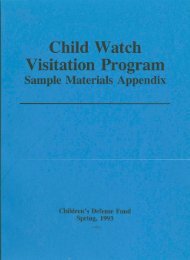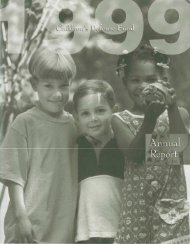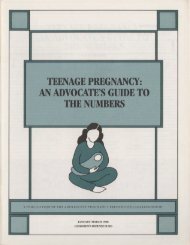child care - Digital Library Collections
child care - Digital Library Collections
child care - Digital Library Collections
You also want an ePaper? Increase the reach of your titles
YUMPU automatically turns print PDFs into web optimized ePapers that Google loves.
THE STATE OF AMERICA'S CHILDREN YEARBOOK 1998<br />
are likely to be born substance-exposed. Barth cited<br />
a study ofCalifornia foster <strong>care</strong> cases where parental<br />
substance abuse was suspected: of 1,576 newborns<br />
brought into <strong>care</strong> in 1995,60 percent already<br />
had at least one sibling in the foster <strong>care</strong> system;<br />
about 25 percent had three or more.<br />
In a 1997 paper for the Executive Session on<br />
Child Protection, Sid Gardner and Nancy Young at<br />
Children and Family Futures in Irvine, California,<br />
also documented the importance of providing services<br />
to mothers with substance abuse problems.<br />
They cited data indicating that a small number of<br />
women who abused alcohol or other drugs while<br />
pregnant accounted for 41 percent of <strong>child</strong> protective<br />
service referrals and out-of-home placements<br />
in the state of Washington. Gardner and Young<br />
described staff training, case assessment, and service<br />
initiatives in Delaware, Washington, and Sacramento<br />
County, California, aimed at building<br />
bridges between <strong>child</strong> protective service agencies<br />
and substance abuse treatment providers.<br />
Children exposed to domestic violence. Children<br />
in families where domestic violence occurs<br />
are at significant risk of being abused. A 1995<br />
review of domestic violence research cited by the<br />
American Humane Association revealed that between<br />
one-third to one-half of <strong>child</strong>ren exposed to<br />
domestic violence are direct victims. Many<br />
more-up to 87 percent by some reports-witness<br />
the abuse.<br />
Child protection agencies are now giving more<br />
attention to these problems. Community partners<br />
in Cedar Rapids, Iowa, identified distinct overlaps<br />
between incidents of <strong>child</strong> and spousal abuse,<br />
which helped the community refocus its energies<br />
on this area. The Family Violence Prevention Fund<br />
in San Francisco has developed a training curriculum<br />
for <strong>child</strong> protection staff and is working with<br />
<strong>child</strong> protection agencies, domestic violence advocates,<br />
and shelter programs to encourage increased<br />
collaboration. Massachusetts, Michigan, and<br />
Washington state train <strong>child</strong> protection workers to<br />
recognize and address domestic violence; they also<br />
sensitize the staff of domestic violence shelters to<br />
<strong>child</strong>ren's needs.<br />
Focusing on Outcomes<br />
.thOugh improvements are being made, the failmgs<br />
of the systems set up to protect <strong>child</strong>ren<br />
~ emain deeply troubling. These concerns have<br />
focused attention on holding <strong>child</strong> protection agencies<br />
more accountable for what happens to the<br />
<strong>child</strong>ren and families they serve.<br />
The new Adoption and Safe Families Act requires<br />
the secretary of HHS, in consultation with<br />
public officials and <strong>child</strong> welfare advocates, to establish<br />
outcome measures for assessing how well<br />
states protect <strong>child</strong>ren and a system for rating state<br />
performance on these outcomes. An armual progress<br />
report is required beginning May I, 1999, in<br />
which the secretary must inform Congress how<br />
each state is doing and how it might improve. HHS<br />
also must develop a performance-based incentive<br />
system for providing federal <strong>child</strong> welfare payments<br />
to states.<br />
This "outcome-based" accountability is also a<br />
part of the reforms sought as state <strong>child</strong> welfare<br />
agencies begin to apply the principles of managed<br />
<strong>care</strong>, or privatization, to their work. The Child<br />
Welfare League ofAmerica found that 31 ofthe 50<br />
state <strong>child</strong> welfare agencies surveyed in 1997 are<br />
incorporating at least some of these principles into<br />
the current management, financing, or delivery of<br />
at least some of their <strong>child</strong> welfare services. This<br />
may mean, for example, "capitated" payments,<br />
whereby the state prepays a fixed amount per <strong>child</strong><br />
for a range of services and the managing agency<br />
then is responsible for providing the needed services,<br />
either directly or through subcontractors.<br />
The agency may retain unspent portions of these<br />
capitated payments, but it also must absorb excess<br />
costs.<br />
Kansas, which has probably gone furthest in<br />
privatizing its services, is holding providers accountable<br />
for achieving specific outcomes in family<br />
preservation, foster family and group <strong>care</strong>, and<br />
adoption. The contract agencies are paid a set dollar<br />
amount per <strong>child</strong> or per family, tied to their<br />
achieving certain outcomes for their caseloads.<br />
Most states are beginning more slowly with<br />
pilot programs that include some managed <strong>care</strong>.<br />
72 CHI L D R EN' S D E F ESE F D














